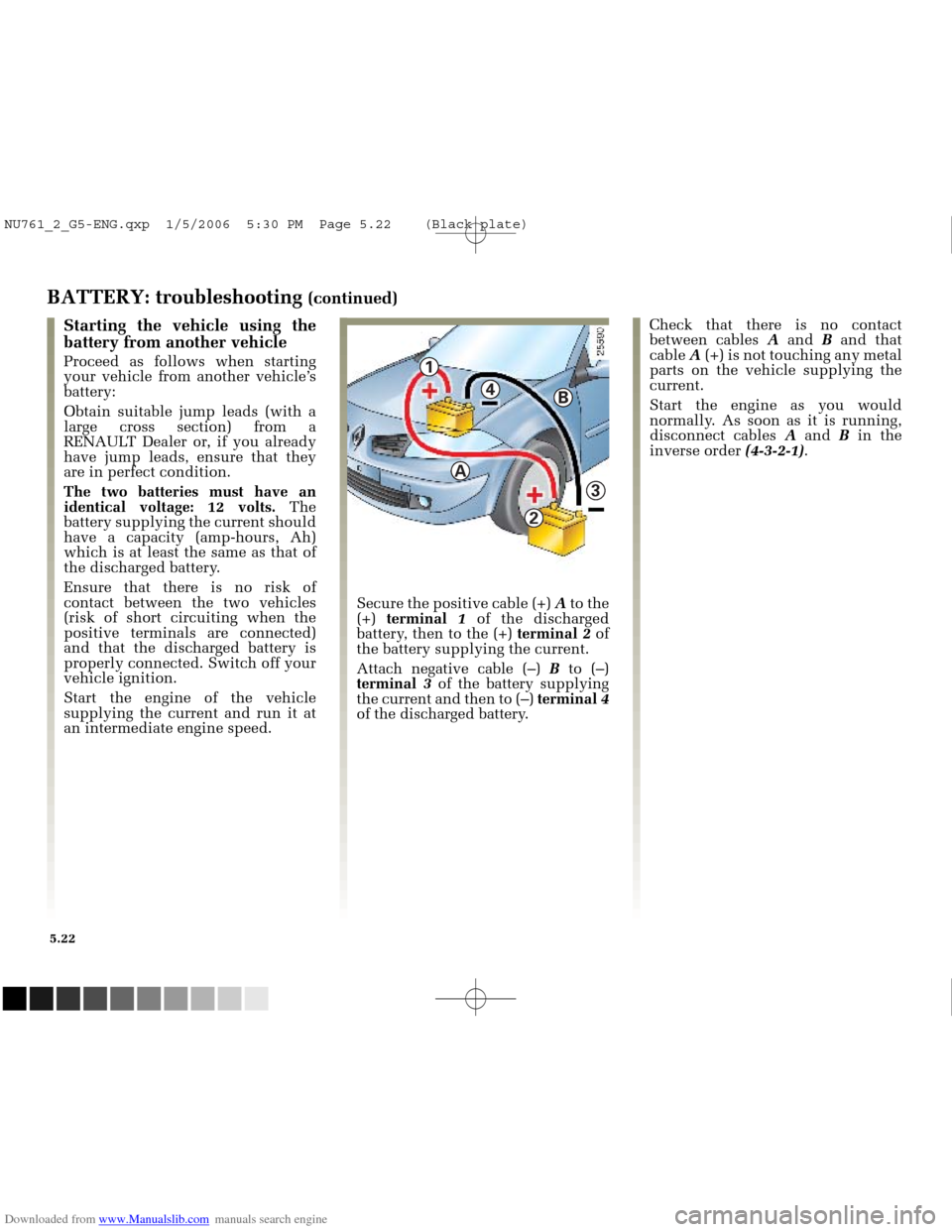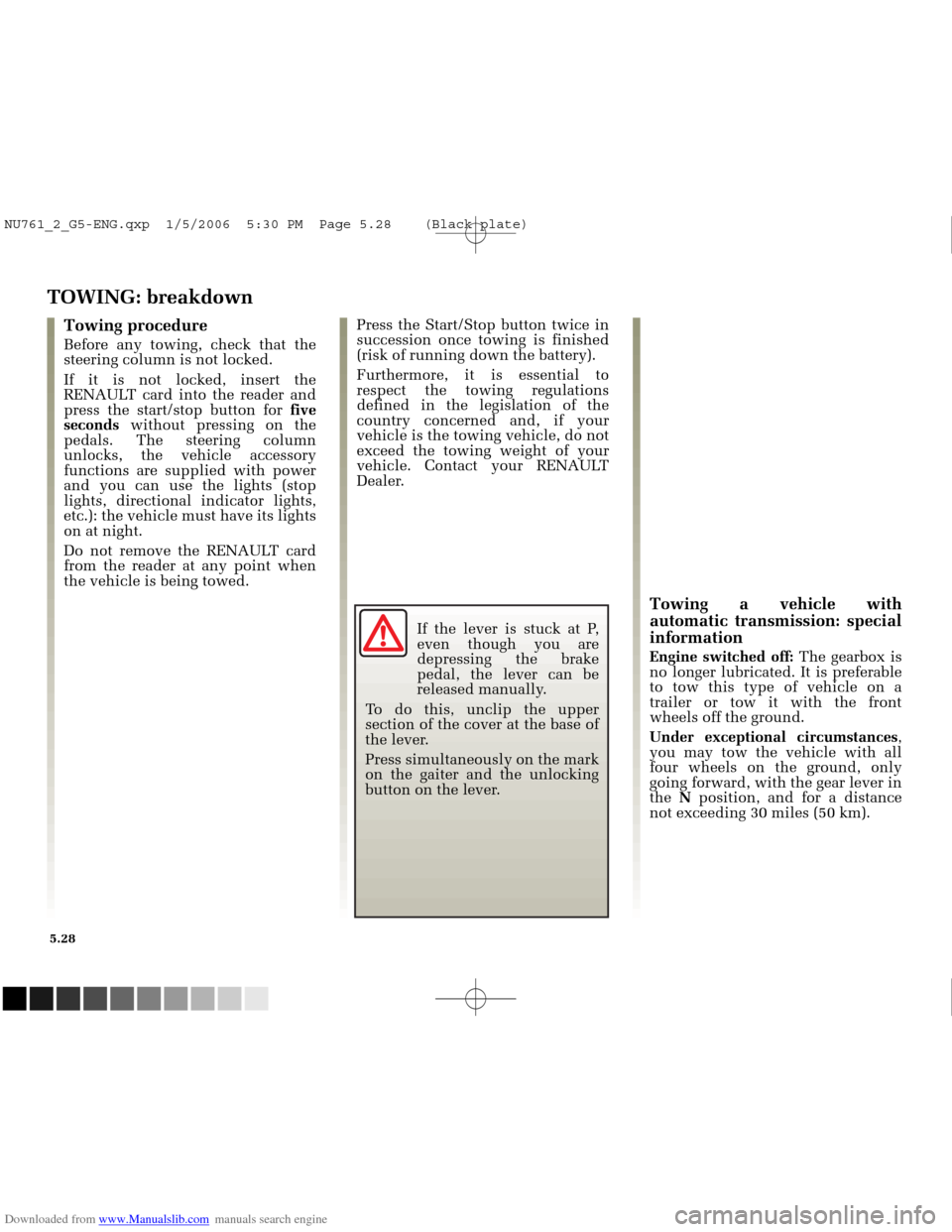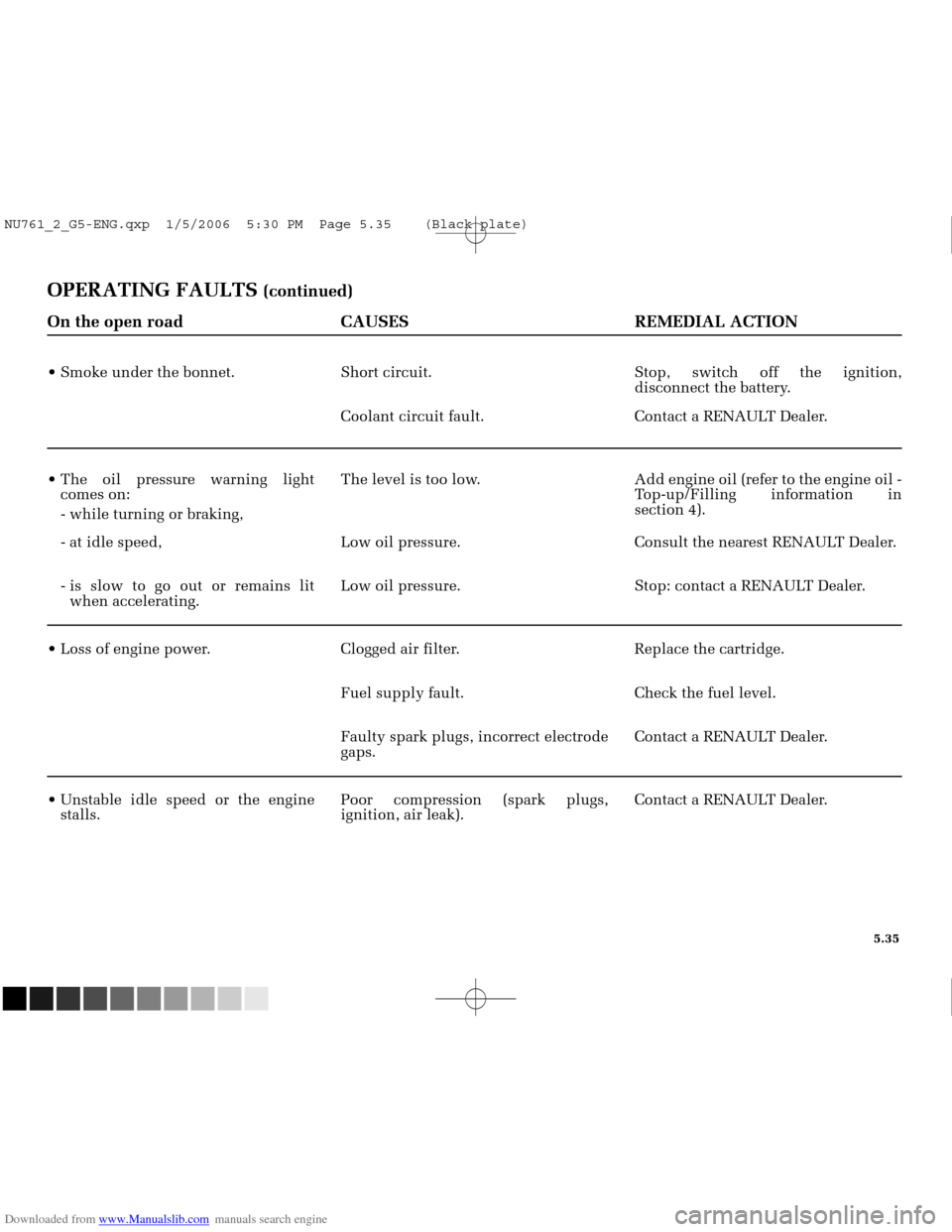Page 208 of 250

Downloaded from www.Manualslib.com manuals search engine
NU761_2_G5-FRA.qxd 4/11/05 11:09 Page 5.20
5.20
BATTERY: troubleshooting
To avoid all risk of sparks:
- Ensure that any consumers(courtesy lights etc.) are switched
off before disconnecting or
reconnecting the battery.
- When charging, stop the charger before connecting or disconnecting
the battery.
- Do not place metal objects on the battery to avoid creating a short
circuit between the terminals.
- Never disconnect a battery less than twenty seconds after the
engine has been switched off.
- Make sure that you reconnect the battery terminals after refitting. Handle the battery with care
as it contains sulphuric acid
which must not come into
contact with the eyes or
skin. If it does, wash the affected
area with plenty of cold water.
Ensure that naked flames, red hot
objects and sparks do not come into
contact with the battery as there is a
risk of explosion.
Take care when working in the
engine compartment as the engine
cooling fan may start to operate at
any moment without warning.
Risk of injury.
NU761_2_G5-ENG.qxp 1/5/2006 5:30 PM Page 5.20 (Black plate)
Page 209 of 250

Downloaded from www.Manualslib.com manuals search engine
NU761_2_G5-FRA.qxd 4/11/05 11:09 Page 5.21
5.21
BATTERY: troubleshooting (continued)
Connecting a battery charger
The battery charger should be
compatible with a battery with a
nominal voltage of 12 Volts.
With the engine switched off, it is
essential to disconnect the cables
connected to both battery terminals,
starting with the negative terminal .
Do not disconnect the battery when
the engine is running. Follow the
manufacturer’s instructions for the
battery charger you are using.
Only a well-charged and well-
maintained battery will have a long
and useful life and enable you to
start the vehicle’s engine normally.
The battery must be kept clean and
dry.
Have the battery’s charge status
checked regularly:
Especially if you use your vehicle for short journeys or for frequent
driving in town. When the external temperature
drops (in winter), the charge
decreases . In winter, only use
electrical equipment which is
really necessary.
Finally, you should understand that the charge decreases naturally
as a result of certain “permanent
electrical consumers” such as the
clock, After-Sales accessories, etc.
When many accessories are fitted to
the vehicle, have them connected
to + after ignition feed . In this case,
it is advisable to have your vehicle
fitted with a battery which has an
increased capacity. Contact your
RENAULT Dealer. If your vehicle is to be left stationary
for a relatively long time, disconnect
the battery or have it recharged
regularly, in particular during cold
weather. The equipment with a
memory, radio etc. will then have to
be reprogrammed. The battery must
be stored in a cool dry place,
protected from frost.
Special procedures may
be required to charge
some batteries. Contact
your RENAULT Dealer.
Avoid all risk of sparks which
may cause an immediate
explosion and charge the battery
in a well-ventilated area. Risk of
serious injury.
NU761_2_G5-ENG.qxp 1/5/2006 5:30 PM Page 5.21 (Black plate)
Page 210 of 250

Downloaded from www.Manualslib.com manuals search engine
4
1
A
2
3
B
NU761_2_G5-FRA.qxd 4/11/05 11:09 Page 5.22
5.22
BATTERY: troubleshooting (continued)
Starting the vehicle using the
battery from another vehicle
Proceed as follows when starting
your vehicle from another vehicle’s
battery:
Obtain suitable jump leads (with a
large cross section) from a
RENAULT Dealer or, if you already
have jump leads, ensure that they
are in perfect condition.
The two batteries must have an
identical voltage: 12 volts. The
battery supplying the current should
have a capacity (amp-hours, Ah)
which is at least the same as that of
the discharged battery.
Ensure that there is no risk of
contact between the two vehicles
(risk of short circuiting when the
positive terminals are connected)
and that the discharged battery is
properly connected. Switch off your
vehicle ignition.
Start the engine of the vehicle
supplying the current and run it at
an intermediate engine speed. Check that there is no contact
between cables
Aand Band that
cable A(+) is not touching any metal
parts on the vehicle supplying the
current.
Start the engine as you would
normally. As soon as it is running,
disconnect cables A and B in the
inverse order (4-3-2-1).
Secure the positive cable (+) Ato the
(+) terminal 1 of the discharged
battery, then to the (+) terminal2 of
the battery supplying the current.
Attach negative cable (–) B to (–)
terminal 3 of the battery supplying
the current and then to (–) terminal4
of the discharged battery.
NU761_2_G5-ENG.qxp 1/5/2006 5:30 PM Page 5.22 (Black plate)
Page 211 of 250
Downloaded from www.Manualslib.com manuals search engine
24089
2
1
NU761_2_G5-FRA.qxd 4/11/05 11:09 Page 5.23
5.23
RENAULT CARD: BATTERY
Replacing the battery
The message “Change card battery”
appears on the instrument panel.
Pull firmly on emergency key 2.
Replace battery 1, observing the
polarity shown on the emergency key.
After the operation, the “Change
card battery” message no longer
appears on the instrument panel.
Batteries can be obtained from your
RENAULT Dealer.
These batteries should last about
two years.
Do not throw away your
used batteries, give them to
an organisation responsible
for collecting and recycling
batteries.
NU761_2_G5-ENG.qxp 1/5/2006 5:30 PM Page 5.23 (Black plate)
Page 216 of 250

Downloaded from www.Manualslib.com manuals search engine
NU761_2_G5-FRA.qxd 4/11/05 11:10 Page 5.28
5.28
TOWING: breakdown
Press the Start/Stop button twice in
succession once towing is finished
(risk of running down the battery).
Furthermore, it is essential to
respect the towing regulations
defined in the legislation of the
country concerned and, if your
vehicle is the towing vehicle, do not
exceed the towing weight of your
vehicle. Contact your RENAULT
Dealer.Towing procedure
Before any towing, check that the
steering column is not locked.
If it is not locked, insert the
RENAULT card into the reader and
press the start/stop button for five
seconds without pressing on the
pedals. The steering column
unlocks, the vehicle accessory
functions are supplied with power
and you can use the lights (stop
lights, directional indicator lights,
etc.): the vehicle must have its lights
on at night.
Do not remove the RENAULT card
from the reader at any point when
the vehicle is being towed.
Towing a vehicle with
automatic transmission: special
information
Engine switched off: The gearbox is
no longer lubricated. It is preferable
to tow this type of vehicle on a
trailer or tow it with the front
wheels off the ground.
Under exceptional circumstances ,
you may tow the vehicle with all
four wheels on the ground, only
going forward, with the gear lever in
the N position, and for a distance
not exceeding 30 miles (50 km).
If the lever is stuck at P,
even though you are
depressing the brake
pedal, the lever can be
released manually.
To do this, unclip the upper
section of the cover at the base of
the lever.
Press simultaneously on the mark
on the gaiter and the unlocking
button on the lever.
NU761_2_G5-ENG.qxp 1/5/2006 5:30 PM Page 5.28 (Black plate)
Page 219 of 250
Downloaded from www.Manualslib.com manuals search engine
NU761_2_G5-FRA.qxd 4/11/05 11:10 Page 5.31
OPERATING FAULTSThe following advice will enable you to carry out quick, temporary repai\
rs. For safety reasons you should always contact
a RENAULT Dealer as soon as possible.
Using the RENAULT card CAUSES REMEDIAL ACTION
The RENAULT card does not unlockand lock the doors. Vehicle located in a high
electromagnetic radiation zone.
Discharged battery. Use the emergency key (refer to the
Emergency key information in
Section 1).
Use of equipment operating on the
same frequency as the card (mobile
phones, etc.). Stop using the equipment or use the
emergency key (refer to the Emergency
key information in Section 1).
Card battery is flat. Replace the battery.
5.31
NU761_2_G5-ENG.qxp 1/5/2006 5:30 PM Page 5.31 (Black plate)
Page 220 of 250
Downloaded from www.Manualslib.com manuals search engine
NU761_2_G5-FRA.qxd 4/11/05 11:10 Page 5.32
OPERATING FAULTS (continued)
When the starter is activated CAUSES REMEDIAL ACTION
There is no response, the indicator lights fail to light up and the starter
does not turn. Battery lead disconnected or terminals
oxidised.
Check battery terminals: scrape and
clean if oxidised and re-tighten.
Discharged battery. Connect another battery to the faulty battery.
Battery unserviceable. Replace battery. Do not push the vehicle if the steering
column is locked.
Warning light bulbs go dim and starter turns very slowly. Battery terminals not tight, battery
terminals oxidised. Check battery terminals: scrape and
clean if oxidised and re-tighten.
Discharged battery. Connect another battery to the faulty battery.
5.32
NU761_2_G5-ENG.qxp 1/5/2006 5:30 PM Page 5.32 (Black plate)
Page 223 of 250

Downloaded from www.Manualslib.com manuals search engine
NU761_2_G5-FRA.qxd 4/11/05 11:10 Page 5.35
5.35
OPERATING FAULTS (continued)
On the open road CAUSES REMEDIAL ACTION
Coolant circuit fault. Contact a RENAULT Dealer.
Smoke under the bonnet. Short circuit. Stop, switch off the ignition,
disconnect the battery.
- is slow to go out or remains litwhen accelerating. Low oil pressure. Stop: contact a RENAULT Dealer.
- at idle speed, Low oil pressure. Consult the nearest RENAULT Dealer.
The oil pressure warning light
comes on:
- while turning or braking, The level is too low. Add engine oil (refer to the engine oil -
Top-up/Filling information in
section 4).
Faulty spark plugs, incorrect electrode
gaps.Contact a RENAULT Dealer.
Unstable idle speed or the engine stalls. Poor compression (spark plugs,
ignition, air leak). Contact a RENAULT Dealer.
Fuel supply fault. Check the fuel level.
Loss of engine power. Clogged air filter. Replace the cartridge.
NU761_2_G5-ENG.qxp 1/5/2006 5:30 PM Page 5.35 (Black plate)